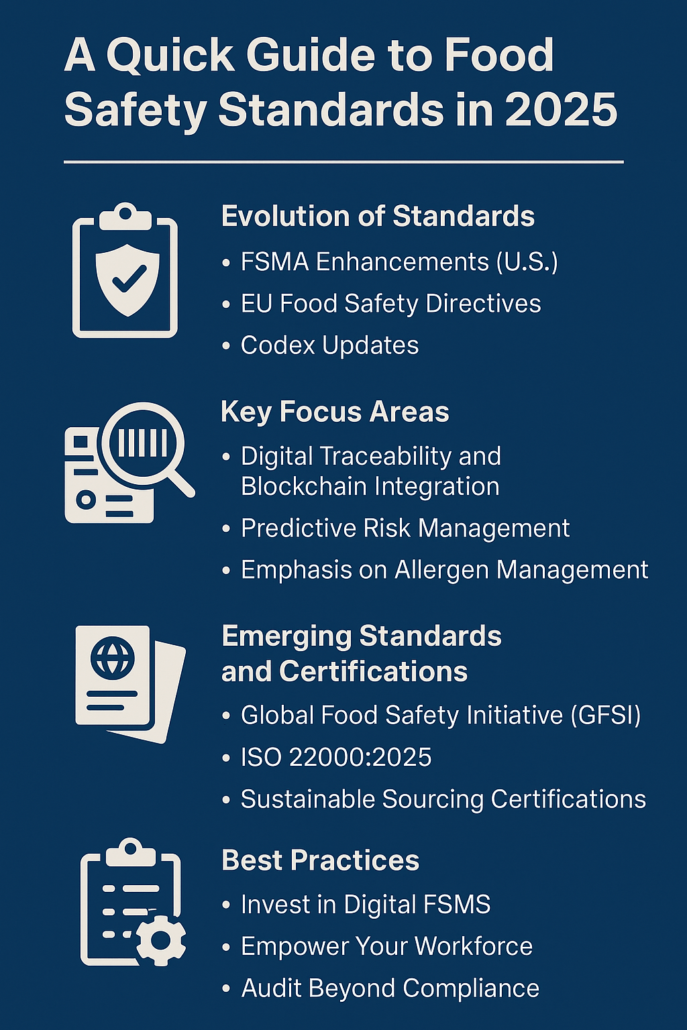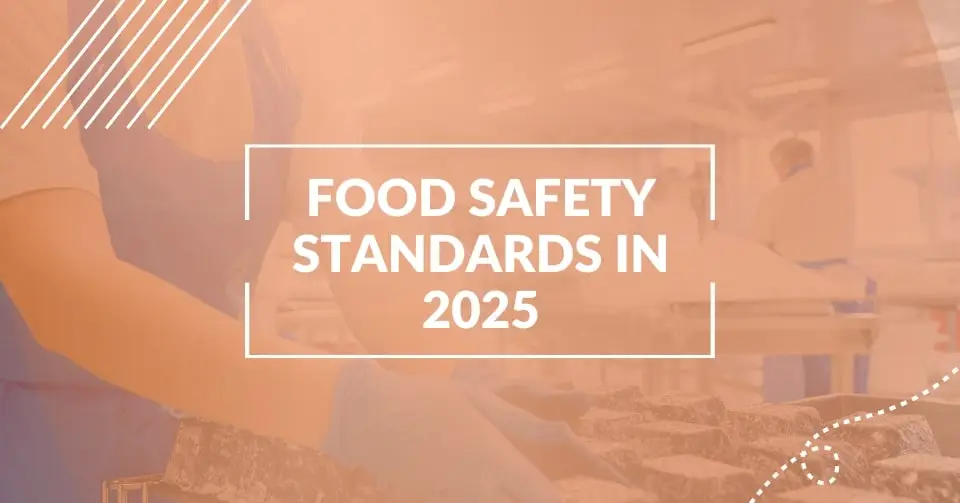Keeping food safe is becoming more complex as technology advances. Consumers expect more and rules get stricter worldwide. Now that we’re nearly halfway through 2025, food companies really need to know the latest on food safety. This guide gives you a simple look at the important trends, rules, and good practices to help your business stay on track and ready for what’s coming.
How Are Food Safety Rules Changing?
Food safety isn’t standing still. In 2025, we’re seeing a big push for companies to prevent problems before they happen, not just react when something goes wrong. Keeping food safe now means actively trying to prevent problems from happening in the first place.
Nowadays, everyone wants to know exactly where their food comes from, like tracing their favorite coffee beans back to the farm! So, having good systems to track all that info is extremely important. Plus, keeping records digitally is becoming the norm to make things clearer, simplify checks, and act fast if there’s a food safety issue.
Big regulatories like the FDA and USDA in the U.S. and the Codex Alimentarius Commission globally are leading these changes. They all agree that we need more transparency in how our food is made, that we should be kind to the environment, and that people should be able to trust that their food is safe to eat.
Let us look at some specific happenings taking place around the world:
- FSMA Improvements in 2025 (U.S.): The Food Safety Modernization Act is getting even tougher on checking if preventive measures are working. Food businesses will be more responsible for ensuring that their suppliers are also keeping things safe on their side.
- EU Food Safety Plans for 2025: The European Union is really pushing for digital ways to track food. This fits with their larger goals for sustainability and their “Farm to Fork” plan, which wants a more sustainable food system from start to finish. Digital tools are key to making both tracking and sustainability better.
- Codex Updates: The Codex Alimentarius Commission is still working to make food safety rules similar everywhere. They’re updating rules for bacteria in different foods and making sure everyone uses the same methods to figure out risks. This helps with international trade and ensures a basic level of food safety globally.
What Should Food Businesses Focus on in 2025?
1. Tracking Food Digitally and Using Blockchain
Knowing where your food comes from is no longer just a good idea – it is the law. Food businesses need to be able to see their entire supply chain from beginning to end. This means using new technologies like:
- Blockchain: Imagine a digital diary that securely records every step a food product takes. This builds trust and shows exactly who handled it at each point. Blockchain, after all, is one of the four key technologies in food traceability.
- RFID and IoT sensors: Think of tiny wireless trackers that constantly send updates on a food’s location, temperature, and other conditions. This helps companies react fast if something isn’t right.
- QR codes for customers: These are like digital labels on packaging. Shoppers can scan QR codes with their mobile smartphones to learn all sorts of nifty information, like where the food came from, how it was made, and if it has any special conditions like safety certifications or allergen declarations. It’s all about keeping customers in the know and making them confident about the food they’re consuming.
2. Predicting and Preventing of Risks
Using smart data analysis with artificial intelligence (AI) is becoming essential for spotting potential food safety problems early. These tools look at large amounts of information from different places, such as:
| Environmental data | Checking things like temperature and air quality in production areas to see if conditions could lead to contamination. |
| Past incidents | Looking at old food safety issues and recalls to find patterns and areas that need better controls |
| Customer feedback | Paying careful attention to what customers are saying to find new safety concerns or product issues. |
3. Managing Allergens Carefully
Undeclared allergens are still a major reason for food recalls in 2025.
That’s why it’s so important to have strong allergen management programs.
This includes:
- Specific allergen plans: Having detailed, written plans that describe exactly how to prevent allergens from mixing at every step, from getting ingredients to labeling the final product.
- Strict cross-contact controls: Following clear procedures to avoid accidental transfer of allergens between different foods during processing, handling, and storage, including thorough cleaning.
- Clear digital labeling: Providing easy-to-understand information about allergens on product labels, often using digital methods to give even more details and warnings about potential risks.
Key Updates in 2025 Food Safety Standards:
Global Food Safety Initiative (GFSI) Requirements:
- Actively finding and fixing possible weaknesses in your food supply chain to prevent food fraud is now a big deal. You need to keep records of your risk checks and the steps you’re taking to stay safe.
- Enhanced measures are mandated for the protection of food production systems against both physical threats, such as intentional contamination, and cyber threats that could compromise food safety.
- Consumers increasingly want food that’s not only safe but also produced in a way that’s good for the planet and fair to people. That’s why getting certified in sustainable sourcing is becoming so important for food companies.
ISO 22000 Enhancements:
- The standard now incorporates improved and more detailed methodologies for conducting hazard analysis and critical control point (HACCP) studies, ensuring a more systematic approach to food safety management.
- Food companies must now consider how changing weather patterns could affect food safety. This includes assessing whether they can still obtain the ingredients they need and whether the climate might attract more harmful pests.
- There is an increased focus on the importance of cultivating a strong and positive food safety culture within the organization, along with a greater emphasis on the role of good leadership in driving food safety performance.

How to Stay a Level Up in 2025?
- Embrace Food Safety Digitization: Digital software can automate paperwork, tracking, and reporting, making compliance that much easier and stress-free.
- Keep Your Employees Trained: A strong, secure food safety culture is something to be strived for and achieved. Regularly train your staff to keep them up to date with new rules, regulations and risks. Prepare them on how to handle potential food crisis situations.
- Go Beyond Basic Audits: Regularly check your own systems and get outside audits to find any weak spots before the rules change.
- Connect Sustainability with Food Safety: Customers and regulators want to see that your food safety efforts also support environmental and social goals.
Is Your Food Safety System Still Paper-Based?
Digitize your HACCP plans, traceability logs, and allergen controls with FoodReady.
Final Thoughts: Building a Safer Food Future in 2025 and After
The year 2025 has been a turning point for food safety thus far. It’s not just about preventing contamination anymore. It’s about trust, being open and being resilient throughout the entire food system. This change is happening because our global food networks are more connected, consumers want more information and accountability, and governments are focused on preventing risks.
Using technology is no longer optional for food businesses that want to succeed. Digital tracking, AI-powered predictions, and better allergen management are huge opportunities to improve food safety and gain consumer trust. It’s also crucial to build a strong food safety and food quality culture within your company. This means continuous training, empowering your employees to be responsible for food safety, and committing to thorough audits that go beyond just meeting the minimum requirements.
Looking ahead, food safety will be even more linked to environmental, social, and governance (ESG) goals. People will increasingly expect food businesses to be sustainable and ethical, recognizing that food safety is connected to how we care for the environment and our communities.
At FoodReady, we understand how complex all of this might be. This is why we’re dedicated to providing businesses with advanced digital tools to manage food safety and quality. With the help of our trusted consultants, we won’t just teach you how to follow the rules and regulations, but instead we will fully assist you in building a business where everyone can trust that the food you manufacture is safe to eat and good for the planet.
FAQ’s
In 2025, food safety regulations have shifted from reactive to preventive approaches and this requires food businesses to now actively manage risks before issues arise. There’s a greater emphasis on:
– Preventive controls validation
– End-to-end digital traceability
– Supplier verification responsibilities
– Global harmonization of standards (Codex updates)
Additionally, regulations now demand sustainability integration and digital transparency in line with consumer expectations and ESG priorities.
The must-have technologies include:
– Blockchain for tamper-proof supply chain visibility.
– IoT sensors and RFID for real-time environmental and product condition monitoring.
– AI-powered data analysis for predictive risk management.
– Digital labeling and QR codes for transparency and allergen disclosure to consumers.
Undeclared allergens continue to be a leading cause of recalls, posing serious health risks. Enhanced allergen management now requires:
– Comprehensive written allergen control plans
– Stringent cross-contact prevention protocols
– Clear and interactive digital labeling for allergens
GFSI now demands:
– Proactive food fraud vulnerability assessments
– Strengthened food defense measures including cybersecurity
– Sustainable sourcing certification as part of food safety programs
Key updates include:
– Advanced HACCP methodologies
– Climate-related risk assessment integration
– Enhanced focus on food safety leadership and corporate food safety culture development
Building a resilient culture requires:
– Ongoing staff training and upskilling
– Leadership commitment to food safety performance
– Empowering teams to proactively report and manage risks
– Routine audits that go beyond regulatory requirements
Sustainability is now inseparable from food safety. Businesses must demonstrate that:
– Their food safety programs support environmental and social goals.
– They source ethically and sustainably.
– Their food safety performance aligns with ESG reporting expectations.







